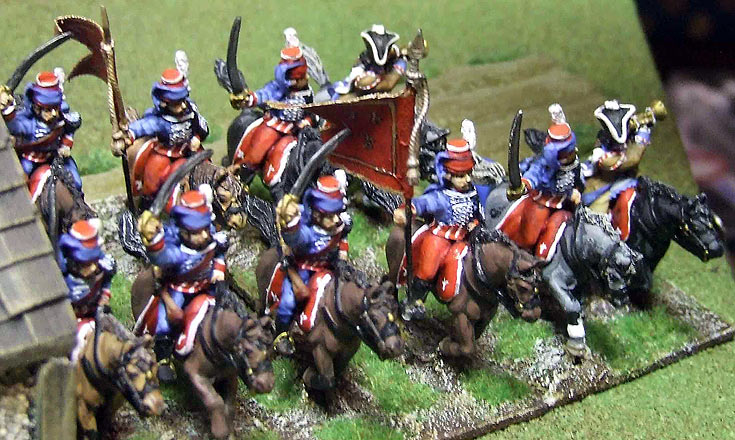
The Grauberg, 1757
5th June 2008, Comments Off
The Seven Years War, Die Kriegskunst, 28mm
The aim of this game was to introduce a handful of new players to Die Kriegskunst – part of a greater bid to convert the world into Seven Years War aficionados. I wanted to run a small game, and came across the perfect scenario in Charles S. Grant’s Scenarios for Wargames (1981), which he tells me is to be reprinted – just after he’s finished toying with his Wargames Companion. The scenario is called “The Dominant Hill”. You’ll get the idea from the map below that the table (a 6×4′ one) is pretty much symmetrical. Both sides come on from either end of the main road, having chosen a force of eight units from a pool, then written down their order of march. In our refight, the Prussians came on from the left, and the French from the right. the objective of both commanders was to capture the “T-junction”, and to control the “dominant hill”. In our game we called it the Grauberg – the “grey hill”.  Strangely enough, both commanders chose identical forces, and identical orders of march – leading with two cavalry regiments, followed by a unit of grenadiers, and five line infantry battalions. Each unit could bring on a unit a turn, so it took a few turns to come into contact. Both sides also split their cavalry – with one unit being sent to contest the hill, and the other into the open ground north of the road.
Strangely enough, both commanders chose identical forces, and identical orders of march – leading with two cavalry regiments, followed by a unit of grenadiers, and five line infantry battalions. Each unit could bring on a unit a turn, so it took a few turns to come into contact. Both sides also split their cavalry – with one unit being sent to contest the hill, and the other into the open ground north of the road. The cavalry clashed while the infantry were still deploying, and the French lost both encounters. I’d just spent a couple of evenings painting up the wonderfully gaudy Bercheny Hussars, so it was inevitable that they would retire in disorder following their first bout with the enemy! At least they did a bit better than the rest of the French horse, who were routed in short order. The Prussian player managed to prevent one of his cavalry units from pursuing the enemy, but the Prussian 2nd Cuirassiers chased the French off the table, and rallied on the French table edge.
The cavalry clashed while the infantry were still deploying, and the French lost both encounters. I’d just spent a couple of evenings painting up the wonderfully gaudy Bercheny Hussars, so it was inevitable that they would retire in disorder following their first bout with the enemy! At least they did a bit better than the rest of the French horse, who were routed in short order. The Prussian player managed to prevent one of his cavalry units from pursuing the enemy, but the Prussian 2nd Cuirassiers chased the French off the table, and rallied on the French table edge. Meanwhile the two infantry forces were coming into action, although the deployment of the French was constrained by the enemy cavalry milling around on his flanks. In a daring display of French élan the Grenadiers de France charged into the Nymschofsky Grenadiers, only to lose the resulting melee. That blew a hole in the centre of the French line, and by that stage the bulk of the Prussian foot had deployed on the hill, threatening the left flank of the small French force.
Meanwhile the two infantry forces were coming into action, although the deployment of the French was constrained by the enemy cavalry milling around on his flanks. In a daring display of French élan the Grenadiers de France charged into the Nymschofsky Grenadiers, only to lose the resulting melee. That blew a hole in the centre of the French line, and by that stage the bulk of the Prussian foot had deployed on the hill, threatening the left flank of the small French force. The only thing protecting these troops from the Prussian cavalry was Dillon’s Irish regiment, who soon had to face a charge from the Prussian cuirassiers. In what turned out to be the only real French success of the evening, the Irishmen drove off the charging cavalry with a highly-effective point-blank volley.
The only thing protecting these troops from the Prussian cavalry was Dillon’s Irish regiment, who soon had to face a charge from the Prussian cuirassiers. In what turned out to be the only real French success of the evening, the Irishmen drove off the charging cavalry with a highly-effective point-blank volley. By that stage it was pretty clear that the French had lost, and in the spirit of the times the two commanders decided to draw a veil over the spectacle. The Prussians had secured the “T-junction”, and were swarming all over the “dominant hill”, so there was little doubt who won the day. As for my gaudy Bercheny Hussars, their time will come again…
By that stage it was pretty clear that the French had lost, and in the spirit of the times the two commanders decided to draw a veil over the spectacle. The Prussians had secured the “T-junction”, and were swarming all over the “dominant hill”, so there was little doubt who won the day. As for my gaudy Bercheny Hussars, their time will come again…

